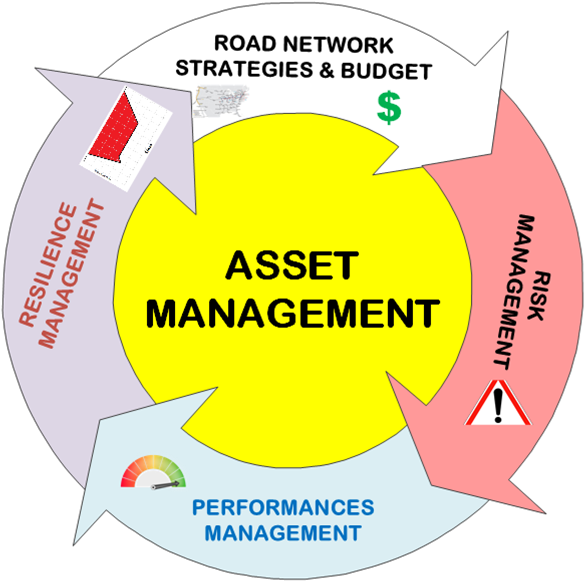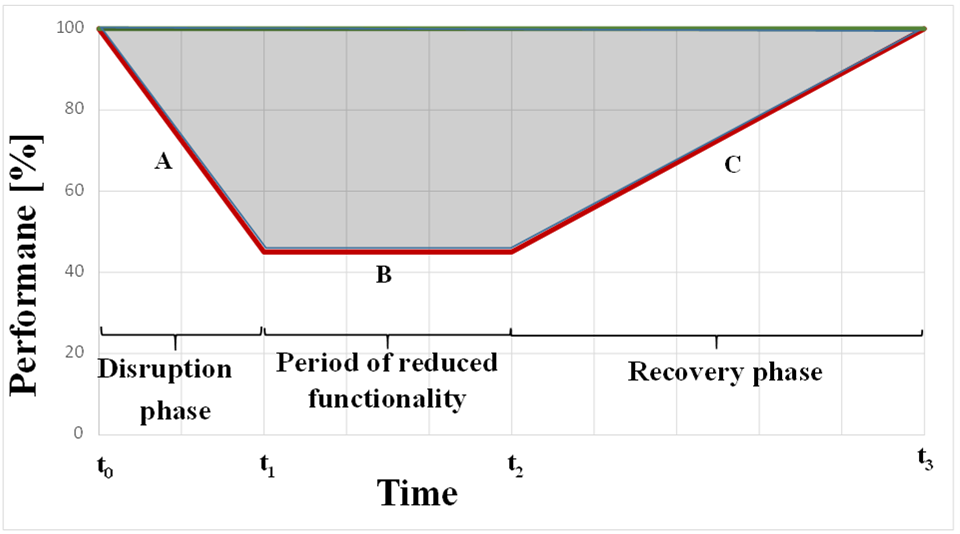

In recent years, many highway agencies have begun to focus on methods to address adverse events that cannot be tackled within the traditional risk-based approach. The focus of asset management activities is to begin from prevention against threats or events that may occur and that may degrade the performance of the asset itself to move towards a new comprehensive “Resilience-based” approach to be able to speed up recovery and restore asset functionality, once disruptive events have occurred. In the following sections, a brief definition of Resilience is provided, the difference between Risk and Resilience is highlighted and a general overview to facilitate the incorporation of Resilience into transportation assets and the corresponding strategies to improve resilience are presented.
The word “Resilience” comes from the field of structural mechanics and it refers to the ability of a material to withstand damaging actions after recovering from a previous yielding state. In the past 50 years, the derivative of this concept, in terms of “ability to recovery from adversities or disturbances”, has been extended to a wider range of fields, such as psychology, ecology, sociology, urban planning and so on. Within the Civil Engineering scope, since early 2000, resilience for transportation networks has been primarily made with reference to the response (impact and reactions) to natural hazards; however, it should be acknowledged that a resilience based approach should encompass all type of hazards (natural and man-derived ones). More recently, ISO introduced the concept of “Organizational Resilience” (ISO 2017) as “the ability of an organization to absorb and adapt in a changing environment to enable it to deliver its objectives” implying that Resilience in Road Asset Management may also deal with socio-organizational issues other than those coping with risk exposure to hazards.
Related to the context of Road Asset Management, it is worthy to highlight relevant differences between risk and resilience (see Fig. 1). While risk is a multi-faceted issue that can be associated with possible threats and opportunities, the risks themselves are not always negative (see the previous chapter) and that risk is strictly related to uncertainty affecting all the processes and interventions within asset management. On the other hand, resilience, although it is based on a risk evaluation, focus on issues related to the avoidance or minimization of disruption to the restoration of initial conditions and to maintain those latter or to the adaptation to a new operating scenario. Simplified, a resilience based approach also addresses the time, insofar as this will affect the recovery performance of the assets and the overall transportation system.

Figure 1. Resilience vs Risk and Asset management
Based on these premises, the risk evaluation framework is seamlessly integrated in the agency’s overall Asset Management approach. It also provides a sound starting point to develop resilience-based strategies and actions and to incorporate them in the overall decision-making process.
Following the identification of possible risks to asset functionality, a risk assessment process requires the definition and the likelihood and consequence of an event or scenario. In this manner, the choice of risk treatment, i.e. an intervention aimed at mitigating the likelihood and consequence of specific risk, shares the same common features with a resilience-based approach. Within a conventional risk-based approach, the likelihoods and consequences of different scenarios that may or may not include maintenance interventions are qualitatively or quantitatively evaluated in to provide information for prioritization and budget allocation. In a resilience-based approach however, these scenarios are enhanced by the time to recover in the aftermath of adverse events which can challenge the ability of the asset to effectively perform its desired function and to implement adaptation strategies.
For example, let us considers the need of improvement of the ability of a road network to withstands a seismic event (namely seismic vulnerability) with reference to its bridge stock (provided that it is possible to evaluate on a stochastic basis the damage scenario induced by a seismic excitation). By using a risk-based approach, a road manager would evaluate a prioritization of seismic retrofitting interventions within a restrained budget allocation. However, it is clear that it would be impossible to strengthen the entire bridge stock and therefore, following a severe earthquake, some bridges would likely be damaged yielding a network disruption that will take some time to recover. On the other hand, according to a resilience-based approach, several additional intervention strategies can be undertaken detailed as follows.
1) Bridges to be retrofitted may be carefully selected in order to reduce the impact of the overall traffic disruption induced by an earthquake and, according to this prioritization scheme, residual bridges that have not been retrofitted for budget constraints and that will suffer for major damages may be restored following the same aforementioned prioritization scheme in the ex-post period.
2) Retrofitting interventions can be adequately designed in order to speed-up repairing actions and therefore the recovery time.
Both strategies may contribute to an increase of the resilience of the road network insofar the functionality of road network will degrade to a lesser extent, as far as the performance level is concerned, because of the first strategy (see “A” section in figure 2). However, in this connection, it has to be acknowledged that a preventive retrofitting action shares the same approach of a risk-based methodology whereas a prioritization in the restoration phase will fall within a resilience-based process.
Furthermore, the network will be restored to its functional condition in a lesser time, according to the second strategy (see “B” and “C” sections in figure 2).
As far as the previous example is concerned, it appears clear that designing and implementing resilience-based strategies require a higher level of information on managed road networks as far as the local seismic characteristics, actual bridge stock structural condition and travel demand.
Keeping all these aforementioned points in mind, transportation organizations have been developing initiatives to incorporate the concept of resilience into transportation asset management systems for more than 10 years. To that end, the first requirement is to align understanding among engineers on what a resilient transportation infrastructure is (i.e. to establish a robust definition of resilience) and how to measure resilience.
The definition of resilience in transportation infrastructure systems have been discussed in the technical literature (Flannery et al., 2018; Zhou et al. 2019). The literature reveals that most definitions characterize resilience from one or both of the following two perspectives: the ability to maintain functionality under disruptions or deteriorating scenarios, and the time and resources required to restore the level of performance after disruptions. Resilience of transport system may be defined as ability of transport system to prepare for and adapt to major disruption, providing and maintaining an acceptable level of service or functionality and responding to and recovering rapidly from disruption. Following the past work of PIARC Technical Committee E.1 “Adaptation strategies and resiliency”, resilience is “an ability of a system or systems to survive and thrive in the face of a complex, uncertain and ever-changing future. Resilience approach is a way of thinking about both short-term cycles and long-term trends: minimizing traffic disruptions in the face of shocks and stresses, recovering rapidly when they do occur, and adapting steadily to become better and able to thrive as conditions continue to change. Within the context of critical infrastructure, the resilience process offers a cyclical, proactive and holistic extension of risk management practices”.
Therefore, resilience measurement includes time and the ability of the asset is able to perform at after an event occurs and before full functionality is recovered (see Figure 2). Resilience also includes adaptation, which implies recovering the infrastructure to a level above the original, which, again, implies strengthening the infrastructure to face a future with extreme events of greater magnitude, specifically those associated with climate change.
Furthermore, if multiple events of varying sizes are expected within a period of time there is the need to evaluate the maximization of the availability of the services provided by the system over time.

Figure 2. Conceptual phases characterizing resilience loss and corresponding measurement
The definition and illustration provided in Figure are consistent with the hypothesis formulated by some researchers that represent resilience as consisting of four contributing factors:
The level of robustness and redundancy are related to performance loss of the transportation system in disruption phase. Robustness measures the ability to withstand disaster-induced damage. Redundancy reflects the availability of alternative resources and at the system level refers to the existence of alternative roads that can provide the service in the event of a disruption or “system priorities that allow for alternative options, choices, and substitutions under stress” (Bruneau et al. 2003). Resourcefulness and Rapidity together determine the ability to restore functionality in the recovery phase.
In order to incorporate resilience into asset management processes, the transportation organization needs quantitative methods to measure resilience of their transport systems to threats that may cause failures. However, especially at an early stage of a resilience implementation process, it is suggested that qualitative measures should also be considered in addition to only a quantitative measure and analysis by using, for example, an Multi Criteria Analysis approach.
Generally, there are two steps to measure a resilience-related parameter. The first step is to assign a metric for measurement, and the second step is to establish evaluation criteria to assess the compliance with the metric. Currently, there is no overall measurement standard for resilience within the roadway network, both in terms of metrics and methods of assessment. Resilience metrics for transportation infrastructure used so far, can be divided into two categories: topological metrics and performance-based metrics (Nicolosi et al., 2022).
Metrics belonging to the first group use topological properties of transportation networks, such as shortest path length, average node degree or centrality (Aydin, 2018) and primarily focus on the layout of the transportation systems while ignoring the dynamic features and the operating condition. In other terms, topological properties such as, for example, the ratio between the number of links and number of nodes that is a numerical parameter related to the redundancy of network as far as the connectivity level is concerned, are mainly based on network layout.
The performance-based metrics measure systems’ resilience based on their performance over the period affected by disasters (disruption, period of reduced functionality and recovery according to Fig. 1). Three most widely used performance-based Measures of Resilience “MoR” identified in the literature are:
An example of a performance-based MoR of the type 1 is proposed in (Bruneau et al 2003 , Bocchini and Frangopol, 2010) and it is represented through Equation 1:

where: RL is defined as the resilience loss, Q(t) is the performance level of the system expressed in terms of percentage of the original asset condition value (prior to disruption event). The latter can be associated to a single or to an aggregate key performance indicator of the asset, or other functionality-based performance index such as the overall travelled time, the overall travelled distance or the overall generalized transport cost within the examined road network. It is worthy to note that the MoR parameter can be graphically defined as the shaded area shown in Figure 1.
For the second type of indicator, resilience is dynamically represented not merely as single parameter but rather as a time dependent function (as opposed to the other types of indicators, where resilience is a steady indicator) that represents the overall effects of disruption in the 3 phases following the occurrence of the event.
In the third type of MoR, resilience is defined as the expected ratio of demand satisfied by the network in the post-disaster phases with specific recovery costs. These indicators thus have two characteristics: 1) they explicitly consider transportation demand; and 2 ) they consider the dependence of the post-disruption phases on the economic resources committed.
Generally, the researchers consider the performance-based metrics more appropriate than topological metrics to measure the resilience of transportation systems, as the latter do not consider traffic flows in the network. However, it is worthy to highlight that some topological metrics have been suggested in order to evaluate redundancy properties of networks affecting overall resilience (Jovanović et al. 2018) and therefore such metrics may be justified in an early stage of a resilience implementation process within Road Asset Management. Among all the performance-based metrics, the third type MoR are preferable as they account for the performance of the system during the whole process, the real operating traffic condition s and the economic resources mobilized. Furthermore, the metrics that include economic resources required for recovery, which influence the recovery time, within the assessment of resilience, are more valuable than the others that usually consider recovery resources as constraints.
In the literature several approaches were proposed to measure the level of functionality of transportation systems and calculate performance based resilience metrics. These performance evaluation approaches were categorized as: optimization models, simulation models, probability theory models, fuzzy logic models, and data-driven models. Among all of them, optimization models are the most widely used.
The identification and implementation strategies to improve resilience in a transportation asset requires a comprehensive approach that is able to take into account all the possible and complex interdependencies between transportation system components and all the foreseeable hazards.
A simplified approach may start from the aforementioned resilience contributing factors (see section 2.5.2) according to which strategies can be grouped as or pro-active actions, if they are dealing with improving robustness and redundancy, and post event actions, if they are aiming at increasing resourcefulness and recovery speed.
In this connection, the former actions can be considered as mainly similar to the risk-reduction strategies (if any) that may have been already undertaken by management, whereas the latter ones can be regarded as peculiar for the resilience management.
ISO 22316 (2017) Organizational Resilience. ISO Standards , 2017.
Flannery, A., Pena, M. A., & Manns, J. (2018). Resilience in Transportation Planning, Engineering, Management, Policy, and Administration (No. Project 20-05; Topic 48-13).
Zhou, Y., Wang, J., & Yang, H. (2019). Resilience of transportation systems: concepts and comprehensive review. IEEE Transactions on Intelligent Transportation Systems, 20(12), 4262-4276.
Bruneau, M.; Chang, S. E.; Eguchi, R. T.; Lee, G. C.; O’Rourke, T. D.; Reinhorn, A. M.; Shinozuka, M.; Tierney, K.; Wallace, W. A. (2003). A Framework to Quantitatively Assess and Enhance the Seismic Resilience of Communities. Earthquake Spectra. 19 (4): 733–752. doi:10.1193/1.1623497.
P. Bocchini and D. M. Frangopol (2010). Optimal resilience- and cost-based postdisaster intervention prioritization for bridges along a highway segment, J. Bridge Eng., vol. 17, no. 1, pp. 117–129.
Nicolosi, V.; Augeri, M.; D’Apuzzo, M.; Evangelisti, A.; Santilli D.; (2022) A Probabilistic Approach to the Evaluation of Seismic Resilience in Road Asset Management, International Journal of Disaster and Risk Science, https://doi.org/10.1007/s13753-022-00395-5.
Aydin, N. Y., Duzgun, H. S., Wenzel, F., & Heinimann, H. R. (2018). Integration of stress testing with graph theory to assess the resilience of urban road networks under seismic hazards. Natural Hazards, 91(1), 37-68.
Jovanović A., Klimek P., Choudhary A., Schmid N., Linkov I., Øien K., Vollmer M., Sanne J.,
Andersson S. L., Székely Z., Molarius R., Knape T., Barzelay U., Nikolic M., Walther G., Lieberz D.,
Maraglino V. (2018) Analysis of existing assessment resilience approaches, indicators and data sources, Deliverable 2.1, SmartResilience Project: Indicators for Smart Critical Infrastructures.
These practices have been tested in several instances and case studies are being prepared. They will be presented here when available. If you want to share a case study, please contact assetmanagementmanual@piarc.org.